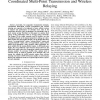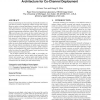85 search results - page 17 / 17 » On Cellular Capacity with Base Station Cooperation |
GLOBECOM
2010
IEEE
13 years 2 months ago
2010
IEEE
Currently, two cooperative transmission strategies, Coordinated Multi-Point (CoMP) Transmission and wireless relaying, are expected to be deployed in future cellular systems to imp...
INFOCOM
2003
IEEE
13 years 10 months ago
2003
IEEE
— As CDMA-based cellular networks mature, the current point-to-point links used in connecting base stations to network controllers will evolve to an IP-based Radio Access Network...
TWC
2008
13 years 4 months ago
2008
Abstract--In a cellular distributed antenna system (DAS), distributed antenna elements (AEs) are connected to the base station via an offline dedicated link, e.g. fiber optics or l...
MOBICOM
2010
ACM
13 years 4 months ago
2010
ACM
Femtocell technology has been drawing considerable attention as a cost-effective means of improving cellular coverage and capacity. However, under co-channel deployment, femtocell...
INFOCOM
2010
IEEE
13 years 3 months ago
2010
IEEE
—In IEEE 802.22 Wireless Regional Area Networks (WRANs), each Base Station (BS) solves a complex resource allocation problem of simultaneously determining the channel to reuse, p...


